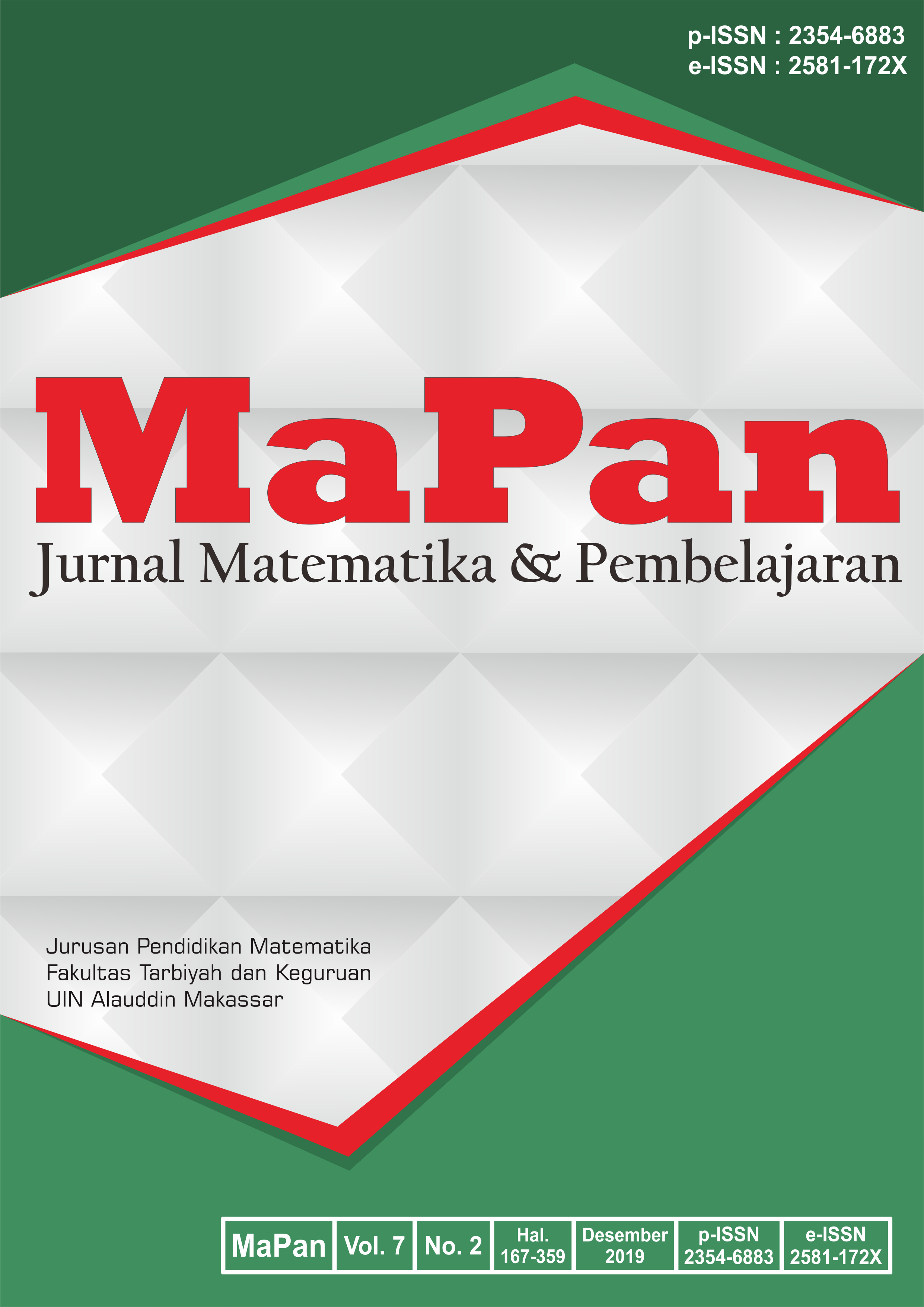ETNOMATEMATIKA: MAKANAN TRADISIONAL BUGIS SEBAGAI SUMBER BELAJAR MATEMATIKA
Abstract
Abstrak:
Penelitian ini bertujuan untuk menggambarkan hubungan antara matematika dan budaya, khususnya pada kebudayaan masyarakat Bugis. Fokus penelitian ini adalah eksplorasi etnomatematika pada makanan tradisional Bugis yang dapat dimanfaatkan sebagai sumber belajar matematika. Penelitian ini merupakan penelitian kualitatif dengan pendekatan etnografi. Instrumen yang digunakan dalam penelitian ini adalah human instrument, di mana peneliti berhubungan langsung dengan penelitian dan berperan sebagai pengumpul data. Teknik pengumpulan data dilakukan melalui observasi, wawancara, dan dokumentasi. Berdasarkan hasil pengumpulan data penelitian diperoleh beberapa makanan tradisional Bugis, yaitu barongko, onde-onde, doko-doko, paso, tumpi-tumpi, jompo-jompo, burasa’, dan putu coppa. Hasil penelitian ini menunjukkan bahwa makanan tradisional Bugis tersebut mengandung konsep matematika yaitu geometri khususnya bangun datar dan bangun ruang. Tumpi-tumpi, jompo-jompo, dan burasa’ mengandung konsep bangun datar, sedangkan barongko, onde-onde, doko-doko, paso, dan putu coppa mengandung konsep bangun ruang. Makanan tradisional Bugis tersebut dapat digunakan sebagai sumber belajar matematika di sekolah khususnya sekolah dasar dan sekolah menengah. Dengan demikian, pembelajaran matematika akan lebih bermakna karena sumber belajarnya berasal dari lingkungan budaya mereka sendiri.
Abstract:
This research aimed to describe the correlation between mathematics and culture, especially in Buginese society. This research was focused on ethnomathematics exploration of Buginese Traditional Food that could be used as mathematics learning resource. This research was a qualitative research with ethnography approach. The research instruments were the researcher who related directly to research and acts as the data collector, observation sheet, and interview. Data collection procedures were carried out through observation, interview, and documentation. Based on data collection, the findings showed that several Buginese traditional foods, such as barongko, onde-onde, doko-doko, paso, tumpi-tumpi, jompo-jompo, burasa’, and putu coppa had mathematics concept of geometry especially plane figure and solid figure. Tumpi-Tumpi, Jompo-Jompo, and Burasa have plane figure concept, while barongko, onde-onde, doko-doko, paso, and putu coppa have solid figure concepts. Those traditional foods could be used as mathematics learning resource for students at elementary or secondary school. Therefore, learning mathematics would be more meaningful because the learning resources base on the students’ cultural environment.
Downloads
References
Abdullah, A. S. (2017). Ethnomathematics in perspective of sundanese. Journal on Mathematics Education, 8(1), 1–16. https://doi.org/doi.org/10.22342/jme.8.1.3877.1-16
D’Ambrosio, U. (1985). Ethnomathematics and its place in the history and pedagogy of mathematics. For the Learning of Mathematics, 5(1), 44–48. Retrieved from https://www.usd.ac.id/fakultas/pendidikan/s2_pen_matematika/f1l3/An article by Ubiratan D’Ambrosio.pdf
Depdiknas. (2003). Undang-undang republik indonesia nomor 20 tahun 2003 tentang sistem pendidikan nasional. Jakarta: Depdiknas.
Emzir. (2017). Metodologi penelitian pendidikan kuantitatif & kualitatif. Jakarta: PT. RajaGrafindo Persada.
Hardiarti, S. (2017). Etnomatematika: Aplikasi bangun datar. Aksioma, 8(2), 99–110. Retrieved from https://media.neliti.com/media/publications/217393-none.pdf
Imswatama, A., & Setiadi, D. (2017). The etnomathematics of calculating an auspicious day process in the javanese society as mathematics learning. In Proceeding of The 4th International Symposium on Mathematics Education and Innovation (ISMEI) (pp. 105–111). Retrieved from http://eprints.ummi.ac.id/95/1/The Etnomathematics of Calculating An Auspicious Day Process In The Javanese Society as Mathematics Learning.pdf
Isnawati, L. Z., & Putra, F. G. (2017). Analisis unsur matematika pada motif sulam usus. Jurnal Matematika Dan Pendidikan Matematika, 1(2), 173–192. https://doi.org/doi.org/10.25217/numerical.v1i2.130
Risdiyanti, I., & Prahmana, R. C. I. (2017). Ethnomathematics: Exploration in Javanese culture. In Journal of Physics: Conference Series (pp. 1–6). Retrieved from https://iopscience.iop.org/article/10.1088/1742-6596/943/1/012032
Sudirman, Son, A. L., & Rosyadi. (2018). Penggunaan etnomatematika pada batik paoman dalam pembelajaran. Indomath: Indomanesian Mathematics Education, 1(1), 27–34. https://doi.org/dx.doi.org/10.30738/indomath.v1i1.2093
Turmudi. (2017). Ethnomathematics: Apa mengapa dan bagaimana implementasi dalam pembelajaran matematika di kelas. In Seminar Nasional Matematika dan Pendidikan Matematika (2nd SENATIK) (pp. 1–9). Retrieved from http://prosiding.upgris.ac.id/index.php/sen_2017/sen_2017/paper/view/1625/1580


